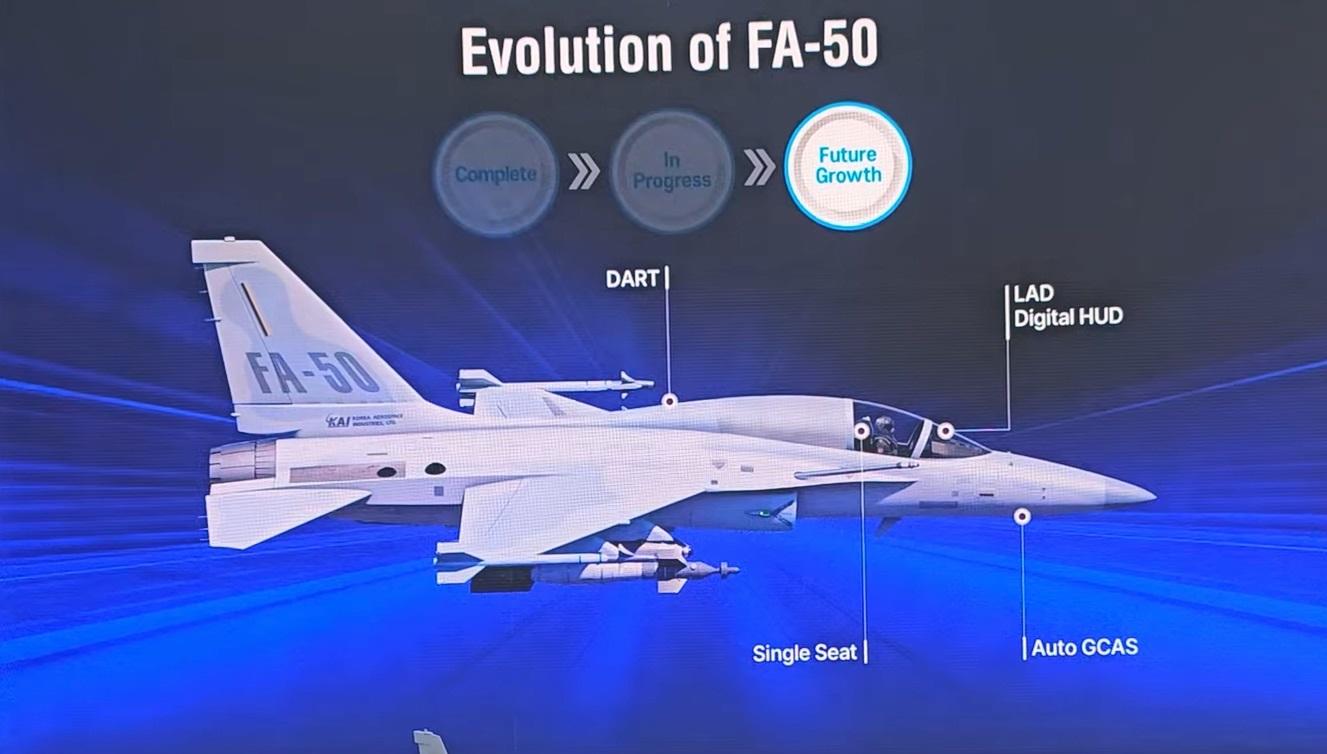Korea Aerospace Industries Ltd. (KAI), the primary military aircraft manufacturer in South Korea, has revealed a fresh investment strategy to craft a single-seat variant of the FA-50 that will cater to the evolving demands in the light combat aircraft market.
According to The Korean Economic Daily, on March 8, KAI’s board of directors greenlit a substantial investment of 90.9 billion won ($68.8 million) to develop a single-seat version of the FA-50 alongside an autonomous aerial vehicle (AAV) project.
A portion of this investment, totaling 35.6 billion won (approximately US$26.85 million), is allocated specifically for the creation of a single-seat FA-50, responding to the escalating global interest in such models.
This initiative aims to broaden product offerings, tap into new markets, and accommodate persistent requests from existing clientele for a solo-seater variant.
KAI’s CEO, Kang Goo-young, underscored the company’s strategic direction, emphasizing the intention to bolster investments in forthcoming ventures to assert dominance in the aerospace sector.

“We aim to increase investments in future businesses to dominate the future aerospace industry,” said Kang Goo-young.
The FA-50, derived from South Korea’s initial double-seater supersonic trainer known as the TA-50, was jointly developed by KAI in partnership with American company Lockheed Martin.
The envisioned single-seat FA-50 is poised to enhance mission capabilities, facilitating air-to-air and air-to-ground combat operations while broadening customer options and diversifying revenue streams.
KAI has set its sights on capturing over 50% of the global single-seat fighter jet market by delivering upwards of 300 units, targeting a segment estimated at around 450 units.
This strategic move follows KAI’s recent triumphs, including the successful export of FA-50 jets to Poland and Malaysia, along with the milestone development of the KF-21, South Korea’s first advanced multi-role fighter aircraft.
In 2023, KAI reported a substantial surge in sales, reaching 3.8 trillion won (approximately $2.88 billion), marking a remarkable 37% upsurge from the previous year.
Why Is S.Korea Developing A Single-Seater FA-50?
During the initial stages of its development, there were discussions about creating a single-seat version of the FA-50 aircraft, but those plans were set aside to focus resources on developing the KF-21.
However, in recent years, strong customer demand has driven growing interest in a single-seat variant of the FA-50 light combat aircraft. This has led to the revival of plans for a single-engine version, designated as the F-50, with development expected to commence this year and completion targeted for 2028, as per earlier reports.
The decision to revive the F-50 project is aligned with a corporate strategic initiative known as “Global KAI 2050 — Beyond Aerospace,” aimed at positioning the company as the seventh-largest aerospace firm globally.
This strategy seeks to reduce the company’s reliance on Korean government procurement and expand its sales in the export market.
Part of this strategy involves tailoring the FA-50 to meet the specific requirements of different nations, particularly those still using older aircraft models such as MiG, Su, F-5, A-37, A-4, Alpha Jet, L-39, and others.
The marketing approach involves a two-stage process: first, targeting nations with legacy platforms and then offering the KF-21 to those countries as a two-tiered fighter force solution.
Additionally, despite the FA-50’s success, customers have expressed interest in enhancing its range. The proposed single-seat F-50 variant aims to address this by incorporating a larger fuel tank in place of the removed back seat, along with other cost-saving measures like eliminating back-seat avionics and the ejection seat.
To minimize development costs, the single-seat FA-50 will retain its current canopy and outer mold line. Additionally, efforts are underway to improve the FA-50’s range through the development of a larger external fuel tank and the introduction of air-to-air refueling capability.
The first adopter of the single-seater FA-50 is expected to be a foreign buyer, with Malaysia being one of the countries targeted for sales.
With Malaysia having already secured a deal to acquire the FA-50s, South Korea anticipates that the Royal Malaysian Air Force (RMAF) may opt for the upgraded single-seat F-50 or KF-21stealth fighter as a potential replacement for its Su-30MKM and F/A-18Ds.
Autonomous Aerial Vehicle
Apart from the investment in the single-seater FA-50, KAI has earmarked the remaining 55.3 billion won of the total 90.9 billion won ($68.8 million) for the first phase of the Autonomous Aerial Vehicle (AAV) project in 2024-2025.
This phase will focus on developing basic and detailed designs, utilizing the company’s model as a basis, and showcasing crucial technologies such as distributed electric propulsion and flight control.
Moving forward, KAI plans to complete vehicle manufacturing and conduct test flights by 2028 as part of the second phase.
The company aims to obtain approval for commercialization from both South Korea and the US Federal Aviation Administration by 2031.
KAI has also disclosed its objective of collaborating with South Korea’s space agency to create a domestically-produced standard AAV platform based on its own AAV technology demonstrator.
This initiative aims to develop models suitable for both civilian and military applications, with the company targeting sales of 23,000 AAV units domestically and internationally by 2050.
- Contact the author at ashishmichel(at)gmail.com
- Follow EurAsian Times on Google News